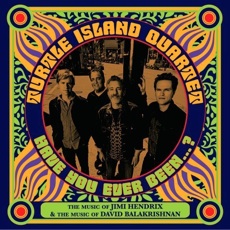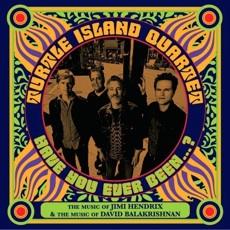
Glee has its fans, and though I’m not among them, I sort of understand. I’m talking about the Emmy-winning TV series, now in its second successful season, about a Midwestern high school glee club. When my kids’ curiosity led me to look at the show, I quickly realized that it didn’t sit right with me on several points, and that these points had something in common. The plots and situations, involving students, teachers, and parents, seemed often artificial and forced, and the witticisms often smarmy. And the musical performances, mostly, were annoying, providing no new insights into that part of the show’s song lists drawn from material I’m quite familiar with and fond of: Broadway and American pop tunes, as well as classic and contemporary rock.
I find myself reacting similarly to much of this take by the Turtle Island Quartet on eight songs from the repertoire of the late rock legend Jimi Hendrix. Like Glee, much of this album comes off as cutesy, and it’s tough to locate its heart and soul within the glitz of its artfulness. That’s not to denigrate the professed adulation of guitarist and songwriter Hendrix by Turtle Island founder and violinist David Balakrishnan. I love Hendrix too, and I much admire the Turtle Island members’ mastery of their instruments and their attempts to adapt their technique to rock conventions.
Listen to the Music
All Along the Watchtower
Related Article
The Wind Cries David Balakrishnan
November 22, 2010
But indulging in “bent” and blue notes, as well as percussive use of the bow and tapping, is not enough to transform a classical ensemble into a rock band. Turtle Island’s eagerness to dress up a familiar hit like Hendrix’s “Voodoo Child” ends up weakening the song’s rhythmic skeleton, and they vitiate the potency of the coda on “Gypsy Eyes” through an ineffectual, grotesque arrangement.
Guests artists Stefon Harris (on vibraphone) and Mike Marshall (mandocello) help widen the palette, and on Bob Dylan’s “All Along the Watchtower” (a favorite of Hendrix’s) and on “Little Wing,” the Quartet’s intention is more tangible. But there’s no tangible reason to have slowed the feisty “Hey Joe” down to Valium tempo, or to truncate the song’s familiar theme, passing it arbitrarily from instrument to instrument. On the plus side, Mark Summer’s cello is well-employed in establishing a bass line (on “Voodoo Child”) and laying down a satisfying solo (“Little Wing”).
Balakrishnan’s own four-part composition, Tree of Life, is a curious amalgamation of genres, the extended first part (“Aswattha”) evoking the unmetered alap section of a raga, with the violin soloing and the other strings providing tanpura-like drone. There follows a rather sour Celtic reel, and then something that might be called chamber danzón, while in his “Monkey Business” Balakrishnan quotes the pop tune “Strangers in the Night.” Again, it’s tough to discern what all this shifty eclecticism is supposed to add up to, and what we’re supposed to feel.
Those seeking revitalization of the concert hall may applaud any such effort as this to cross over to hip material. Those with a deep love of forthright rock, though, are likely to come away less than satisfied, if not outright irritated.

